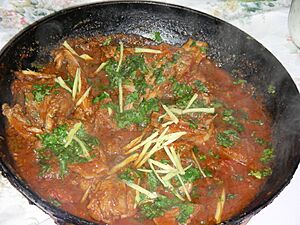Balti (food) facts for kids
A balti is a special type of curry dish. It gets its name from the thin, pressed-steel pot, called a "balti bowl," that it's cooked and served in. Think of it like a wok!
Balti curries are cooked very quickly. They use vegetable oil and high heat, similar to a stir-fry. Any meat in a balti is cooked off the bone. This is different from many traditional Indian curries, which often simmer slowly for a long time. The sauce usually has garlic, onions, turmeric, and a mix of spices called garam masala.
People enjoy balti in Pakistan, North India, and places like Great Britain. It seems to have first arrived in England in Birmingham around 1971. Some people believe it originally came from a place called Baltistan in northern Pakistan.
Where Did Balti Come From?
The word "balti" comes from the pot itself. In languages like Hindustani, Odia, and Bengali, "balti" means "bucket." This word actually came from the Portuguese word balde, which also means bucket or pail. Portuguese sailors brought the word to the Indian subcontinent in the early 1500s.
Some food experts, like Pat Chapman, think the cooking style might have started in Baltistan. This area is in northern Pakistan and shares a border with China. In Baltistan, they use a cast-iron wok that looks a lot like the balti pan. Chapman suggests that balti cooking might have influences from Chinese and Tibetan cooking styles.
However, other experts, like Colleen Taylor Sen, say that the food eaten in Baltistan today doesn't look like the balti curry we know. So, the name might just come from the pot that looks like a "bucket."
In Birmingham, England, a restaurant called Adil's is often said to have served the first balti in 1977.
Balti Restaurants
In Birmingham, England, restaurants that serve balti are often called 'balti houses'. These places sometimes have glass over their tables with menus underneath. They also often serve large pieces of karack naan bread, which are meant to be shared by everyone at the table.
Many balti houses were first found in an area of Birmingham called the 'Balti Triangle'. This area includes Ladypool Road, Stoney Lane, and Stratford Road. Even though a tornado caused damage there in 2005, most restaurants reopened by 2006.
Balti restaurants have become very popular. They have spread beyond Birmingham to other parts of the West Midlands and then across much of Britain. The curry market in Britain is now worth a lot of money each year. Some people still believe that you can only get a "proper" balti in the West Midlands area.
Outside of Britain, you can find a few balti houses in Ireland and other English-speaking countries like New Zealand and Australia.
Since the late 1990s, supermarkets in Britain have started selling pre-made balti meals. This means balti restaurants now have more competition.
See also
 In Spanish: Balti para niños
In Spanish: Balti para niños
Images for kids




